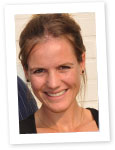Progress in HIV Care and Monitoring in Curaçao
| Gonneke Hermanides has been based in Curaçao the last few years and h as recently returned to the Netherlands to complete her PhD thesis. In the following article she shares with us some insights into her work in Curaçao, particularly in relation to the effect of combination antiretroviral therapy (cART) in the adult population. |
 |
In 2005, a partnership between the Stichting HIV Monitoring (SHM), the Red Cross Blood Bank Foundation Curaçao and the St Elisabeth Hospital Curaçao was set up. Every day, clinical, immunological and virological data of HIV-infected individuals are collected in the hospital in Curaçao in accordance with the SHM guidelines and entered and stored in the online central SHM database in Amsterdam.
The monitoring and evaluation of HIV-related care through registration in one central database has advantages for the disease management of both the individual patient and the population. At the patient level the data set ensures continuity of care, as each patient’s complete medical information is available for the healthcare provider in an orderly manner. And at the same time the data of patients who first received medical care in the Netherlands becomes available as soon as they start to receive care in Curaçao. At the population level the data and available analyses are used to implement the policy changes that are needed for the evolvement of HIV care on the island. The brief description below of the study performed by Hermanides et al. is an example of how data are used for the development of HIV-related care in Curaçao.
The effect of combination antiretroviral therapy in the HIV-1-infected adult population in Curaçao was assessed by comparing it with the effect of cART in 3 different HIV-1-infected populations in the Netherlands: the Antillean, Surinam and Dutch populations. A total of 2118 therapy-naive patients from the SHM database was included in this study. All included patients started cART between January 2005 and August 2008. One remarkable fact was that more than half (63%) of the population in Curaçao started cART in advanced disease stage (CD4 cells <200 cells/mm3). The immunologic recovery after 6 months of therapy was therefore lower in the population of Curaçao (110 cells/mm3) compared to the Antillean (160 cells/mm3), Surinam (150 cells/mm3) and Dutch population (150 cells/mm3). The proportion of patients with an undetectable viral load after 12 months of therapy was also lower in the population of Curaçao (76%) compared to the Antillean (87%), Surinam (93%) and Dutch population (96%). And the percentage ‘lost to follow-up’ after 30 months of cART was higher in the population of Curaçao compared to populations treated in the Netherlands. A higher percentage of patients from Curaçao (10%) had disease progression after 12 months of cART, which was defined as death or progression to a CDC-C event, compared to the Antillean (5%), Surinam (6%) and Dutch population (7%). The late start of cART, as well as the limited viral response, contribute to a poor clinical outcome for HIV-1-infected patients who start cART in Curaçao compared to patients in the Netherlands.
In the next few years attention will need to be given to the early diagnosis and referral of HIV-infected individuals in Curaçao with the objective to start cART at an earlier stage of the infection. In addition, interventions are needed which focus on long-term patient assistance in order to lower the number of ‘lost to follow-up’ patients and enhance therapy compliance.
Many thanks to Luuk Gras, Ard van Sighem, Carel Winkel, Izzy Gerstenbluth, Frank de Wolf and Ashley Duits.
